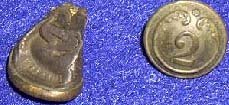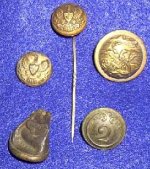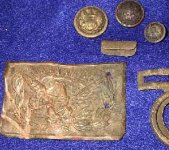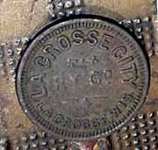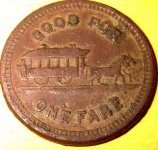Night Hunting
Night Hunting
This article is for those who want to try to do some night hunting and make some great finds while doing so.
Night Hunting
After discovering certain locations such as sidewalk replacements and house demo sites, held some great finds. I had decided to focus on those areas for the majority of the time I put into metal detecting. The number one draw back to hunting these locations was: 1. Permission, this tending to not be given for one major reason that being liability. This was due to the fact that the crews were using heavy equipment most of the time. They just did not relish the idea of watching over their shoulder's for folks poking around in the dirt. Those who try to detect while these crews are working are foolish and also not helping the image of the hobby. After getting to know those in charge of these projects and developing a friendship, they realized that i was one, who respected their wishes to stay out of harms way. They were fine with my wanting to metal detect the locations, but only after their work day was finished. So permission was granted and I was lucky to have many great hunt sites.
At the time when i was doing all that night hunting back in Wisconsin, i happened to be working a 2nd shift job in a warehouse. The town i lived in dated back to the 1850's, and seemed to have had 20,000-30,000 residents for most of the late 1800's. This meant there were thousands of dropped coins, tokens and many other highly prized items to find. Now the reason i focused on those side walk and house demo sites, was very simple, the sidewalks were the main foot traffic areas for decades, and a shaved down yard was easy pickings for that $200 Radio Shack detector i owned at the time.
Well, now i've covered the type of area i hunted, a mid-sized midwestern city with some history to it. I did not hunt city parks at night, that would of only been a problem due to digging in a well-kept grassy area. Imagine the holes folks would of seen come daylight. The areas i mentioned had no grass to get damaged. There was only dirt, and much of it was moved around daily. Digging was simple, you could make any size hole you needed, just kick the dirt back in when you retrieved the target. The only time i did not hunt a side walk demo site, was once the surface was prepared for the concrete to be poured the next day. This is only common sense, respect the work of those construction crews. Follow these suggestions on hunting these sites, and you might find that night hunting can be very rewarding. Next the equipment i used, and what i consider to be all one needs to have a productive hunt.
The Equipment
Now back then I used a low-end metal detector. It was made by Bounty Hunter for Radio Shack. It cost about $200 at the time of purchase. I believe it was known as the "Land Star" at that time. But now there appears to be another model using this name. Either way, they will both work for this style of hunting. The model I used had, All-Metal, Notch, and Auto-Notch features. I turned the sensitivity up as high as the ground conditions would allow. If it was too erratic than i lowered it a might. The discrimation was turned real low, well below accepting nickle. Looking back, I most likely ran the discrimation too high. Now this detector had a indicator that would point in different areas, iron, nickle/pull-tab, screwcap, zinc penny, penny, dime, quarter, half, dollar. But that did me no good with my night hunting, for i did not use a light at all. I went by sound when digging my targets, there were three different pitch sounds given off by the machine. Also i used headphones, this helped to hear the signals and lessened the chance of drawing unwanted attention. The unwanted attention could be anything from a drunk person, to a dog in someones yards. Nothing is so irritating when hunting a good location, then to have to leave because the dog is bound and determined to wake the whole neighborhood.
The Sounds of Targets This section will be about the types of sounds different targets produced, and those i choose to dig.
Other things to cover!
Weather conditions such as a good rain. Concrete forms and rebar rods. dd coils, Free's Mxt upgrade and relic mode hunting. This post and the one above it will be moved lower in the order of presentation. I just wanted the reminder for myself to mention these things.
Other Metal Detectors
Now, i also used a couple of other models of metal detectors. There was a Bounty Hunter model produced for Wal-Mart. It had a needle gauge that seemed to fly to the right on just about everything, it also gave only one tone if I remember correctly. It could also be used to hunt at night, but one would have to dig ever signal. This kind of machine can be a real pain to hunt with, but in theory the chances of missing a real good low reading target are slim, but like i said, one has to dig everything. Many start out with this kind of detector, so to enjoy the hobby and reap the rewards of some good finds, hunt those sidewalk demos and shaved down house yards. My best with this model, was an 1887 seated dime.
The MXT Upgrade and Night Hunting
This metal detector, used for night hunting, combined with a DD coil, i found to be a great machine for night hunting. But it had to be used in relic mode. The coin mode even for day hunting, i found took much of the enjoyment out of metal detecting for me. In coin mode too much of my time was spent looking down at the meter, which did not light up for night hunting, this also tended to cause a sore neck. So switch it to relic mode. In relic it produced two tones, one low for iron, and a high tone for anything else. During my night hunts in relic mode with headphones, I could keep a eye out for people walking home drunk from bars, dogs or any other unpleasant surprises. The basic settings for the MXT for night hunting are relic mode, Gain as high as the ground conditions allow, Dual Control (Discrimation) about a 2, which should allow you to pick up those Liberty and Shield nickles. Any detector that gives muti-tones would be a plus for night hunting.
What Else to Carry
The things i used were headphones for various reasons, keep the noise down, pro-long battery life, eliminate traffic noise. Digging tool, just a study trowel and a shovel in the trunk of my car. (The shovel will covered later in the ground conditions section). Finds bag/pouch, mine was a marble bag. I found a marble bag worked well for a couple of reasons. One was it was deeper and had a draw string, this insured that my finds were still in the bag after the hunt. Other items to carry are up to who ever is doing the hunting. I never had a good tool type belt to place my pinpointer, so that is why i never really depended on one. Water bottle and those little extras i had in the car. I found just carrying what was needed for the moment work the best for me.
Ground Conditions
The ground conditions in various parts of the United States vary considerably. There is no set answer, how deep older coins can be found. In the mid-west where I was from, the fall leaves and decaying grass create new layers of top soil. If one sees a shaved yard in day-light in the midwest, they would notice looking at the edge of the project, where the cut was made, that down a couple of inches is a layer of darker dirt. This darker dirt is what i always looked for, it held the older items. Some areas on the other hand such as the sidewalk replacements, had fill dirt or sand poured over them before the walk was poured in the past. At other times, i have found older coins right on top exposed to the air after an old cracked side walk was removed. The best bet to finding this payoff layer in whatever area you hunt is to, dig all targets until you start to find old square nails and old scraps of brass. This trash from the past, lets you know you are hunting the correct layer to find older coins.
The Shovel
Remember that shovel in the trunk of my car? Mine had come in handy on several occasions. I was hunting this side walk tear up area and one night we had a heavy down pour. The rain had fallen on a blacktop parking lot and ran off in the direction that caused it to wash away a section of of the exposed soil under the removed side walk. It must of cut away at least a foot of soil in several spots. I swung my coil in these areas and in most of them dug deeper coins. It was then that i first discovered the thinner even older cement walk that existed before the one the city had removed. This section actually had 3 different sidewalks, all placed above the previous one. Seeing as how they were redoing the whole area, I took my shovel and scraped the top layers off and found several Liberty nickles. Of couse i also replaced the moved soil, so no one sprained an ankle. Sometimes spreading this older dirt around and then scanning it will allow one to get that extra coin or two. Hard work, but when they are the old ones i think it is worth it.
The Scouting Report
This is about night hunting, but there are certain things one can do during the daytime that are hard to do during the hours of darkness. Finding those locations where the good finds lay is important. By driving around to work, appointments and shopping, I always took a sightly diiferent way each time. I was finding where the sidewalk replacement projects where at. Those barricades set up, to block off a section of walk, were what i was looking for. I made note of them and returned to hunt them, after those work crews were finished for the day. There were other signs that a section was due to be worked on in the future. I made mental note of sections of walk that were buckled up and had been spray-painted. These were to be worked on soon too.
The Scouting Report Part 2
Old yards hold many good finds, if they are old, then they tend to be deep. House demo sites are great locations if they are removing the original house to build a new one there. Sometimes they remove several houses in a row to build a large apartment complex. If these locations are in a older part of your home town, so much the better, this means more time swinging the coil. These sites can be spotted before the work ever gets underway. Look for condemned signs on the house/houses. Also look for boarded up windows and doors, in time these will be most-likely coming down. Check local newpapers for stories of construction projects and other items such as the house that caught fire and suffered major damage. Drive by these locations and keep an eye out for when they are prime for hunting. If after removing the debris, they shave the top of the soil off, then any low cost metal detector can make great finds. These are nice spots for night hunting.
Weather Conditions The best times to hunt are right after a good rain, the heavier the better! There are several reasons for this:
Hunting after a heavy rain.
It seems from my experience that hunting after the ground is saturated from a heavy rain, that one can receive signals that are deeper than when the ground is dry. Of course, we can get a bit muddy, but if that stopped us, one would not be interested in metal detecting. I have dug coins as deep as 10 inches in wet soil. It also seemed to me that small pieces of brass tended to be detected more often in these wet soil conditions. Also digging a target is much easier than when the ground is sun-baked and dry.
I just have to finish this one and then post some pictures and it is ready. I got the ending all hand written. Problem is before i finish a story, i start another one.
The Sounds of Signals
As mentioned earlier, I am covering 2 different types of metal detectors. The first was a machine much like the White?s MXT which in relic mode produces 2 tones, low for iron and a higher tone for any target that is non-iron. The other type of metal detector, I am covering is a low-cost multi-tone unit. An example is the Bounty Hunter Land Star. With these multi-tone units, learn the various tones produced by various targets. Iron will produce one (low) tone. Foil-nickel-pull tabs will produce another slightly higher tone. Coins such as dimes, quarters, and halves will produce a higher tone. These various tones will vary with the make and model of your machine. The tones will be important once you learn what your machine is telling you. The best way to learn the sounds of old coins is to scan samples of these older coins to see what tone your machine wants to emit. But if you do not have any older coin types, I will be working on this in my other article entitled, Does Your Metal Detector Lie??
Hunting Style and Speed
Hunt how you want, never rush when hunting. Moving too fast, we miss covering an area well, we also loose depth. Just use good basic detecting skills. A rusty object scanned too fast can give a good signal. Stopping to dig the target we can end up with a rusty bottle cap. A frustrating waste of time. Why rush, after all it has been laying there for many years, (enjoy the hunt). Good technique practiced when hunting combined with simple record keeping will in time, tell a story. The numbers of older interesting finds will increase. This simple fact proves the individual is making improvements in many areas. These will include: Hunt Site Selection, Interpretation of signals (knowing I better dig, it was a good one last time) and proper coil swing speed.
Other Little Tricks
When hunting cover the area going one direction, then from another. One can go right over a coin or token by only hunting in one direction. By covering the area from as many directions as possible you can get that last item or two in your finds pouch. This has worked for me many times over in the past. Give it a try and see if it works for you.


